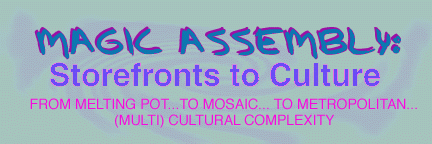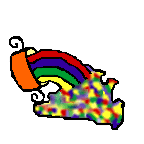
The Magic Assembling:
Metropolitan Toronto Storefronts
and Street Scenes

The Magic Assembling:
Metropolitan Toronto Storefronts
and Street Scenes
© 1991 Multicultural History Society of Ontario
© 1991 Multicultural History Society of Ontario
From almost every country in the world the immigrants come like the magic assembling of a hundred constituents to form a chemical compound. The elements that are to make the future Canadian are varied in national color and character. Canada is the vast laboratory of grace in which God is fashioning the final man. The final race will not be any one nationality, but will be composed of elements from all races.
C.J. Cameron, Foreigners or Canadians?, 1913
FOREIGNERS? ALIENS? OTHERS?
Foreigners? Aliens? Others? These are some of the words
that have been used in Canada and elsewhere to describe groups
deemed to be different. Other terms include ghettos,
ethnic enclaves, Little Italies, and
Chinatowns. As Robert Harney put it in his book
Gathering Place in 1985, these terms do not "describe the
social system and cultural life of particular groups of people in
the city." Rather, they "delineate the categories which such
groups are supposed to inhabit." People who accept these
categories make no attempt to learn about or to understand these
groups.
This problem of terminology is ultimately a political problem. As
participant observers and political actors, we must realize that
our words and understandings are never neutral, just more or less
biased. This said, the challenge remains one of building (rather
than burning) our bridges. Bridge building within and between
cultural groups takes many forms, whether it be exhibits such as
this one, or the acknowledgement and fostering of minority
discourse.
Where immigration to Canada is concerned, understanding and
tolerance are particularly important now, a time when immigration
- at close to half a million in 1991 and 1992 - has reached levels
that have not been seen since the first decades of the twentieth
century.
FOREIGNERS OR CANADIANS?
Foreigners or Canadians? The problem with this question
is that it transforms complex cultural issues into a single false
and simplistic division. First Nations peoples, Canadians and
non-Canadians all have many different identities, and in areas
like Metropolitan Toronto, to be a Canadian is to be a part of one
of the most ethnically diverse urban populations in the world.
Since the formation of the Municipality of Metropolitan Toronto in
the 1950s, immigration into the metropolitan area has gone hand in
hand with dynamic economic and cultural development. Given this
history, Metropolitan Toronto remains the number one destination
for immigrants to Canada. It is not surprising, therefore, that
the study of ethnicity in Canada is best understood when it is
integrated into an urban framework. "No great North American city
can be understood without being studied as a city of immigrants,
of newcomers and their children, as a destination of myriad group
and individual migration projects." When Professor Robert Harney
made this statement in 1985, he invoked this warning from Italo
Calvino's "pseudo-geography," Invisible Cities: "Beware of
saying to them that sometimes different cities follow one another
on the same site with the same name, born and dying without
knowing one another, without communication among themselves."
Getting beyond this lack of comprehension was one of Harney's
objectives. He spent several days before his sudden death in 1989
on the streets of the City of Toronto, beginning a project of
documenting urban storefronts and street scenes. This exhibit
includes some of the results of the photographic work he directed,
in addition to new words and images that extend beyond the city
into the metropolitan area.
STOREFRONT SERVICES
The [person] who had conquered the vagaries of English, [who] could understand or circumvent the law, and [who] had some sense of the situation could become the most important person in the "immigrant community." People expected to pay in "cash and deference" for "the use of knowledge of Canada" and its workings. A semi-professional, commercial, and bureaucratic bourgeoisie was and is as much a part of an ethnic neighbourhood- as their shopkeeper brethren.
Robert F. Harney and Harold Troper, Immigrants: Portrait of the Urban Experience, 1975
The storefront services run by immigrants play an important role
in helping newcomers to adapt to and be assimilated in Canadian
culture. At the same time, these services enrich and are part of
the ongoing change in our host Canadian culture.
Immigrants need the services of experienced professionals from
their own groups not only for their fluency in the English
language, but also for their knowledge of Canadian economic,
legal, and administrative practices. Accountants and lawyers,
bankers and travel agents offer services alongside cleaners and
tailors, florists and acupuncture therapists. Altogether, these
businesses bring a wide variety of international goods and
services to city streets.
It is true that the federal government sets broad policies for
immigration, refugee status, international development, and
foreign aid. At the local level within Metropolitan Toronto,
however, thousands of immigrants earn their living through wage
labour and the businesses they run. Often they share their
prosperity with relatives and friends in their country of
origin.
CULINARY CULTURES
Virtually every immigrant group has established its own grocery
stores, restaurants, and import and distribution companies. These
ethnic establishments not only provide for the special dietary
needs of their people; they also add to the number and the variety
of goods available in Metropolitan Toronto.
* In Rexdale, a Jamaican vendor of tropical fruit and vegetables, meat and fish, beckons to customers from the Caribbean community.
* An Italian meat wholesaler in the City of York has expanded from his traditional market to cater almost exclusively to a new and growing West Indian clientele.
* In the City of Toronto, an elegant restaurant and banquet hall serves authentic Greek cuisine.
* An Indian grocery and variety store in North York seeks a larger clientele with a storefront sign in English and Italiese (Italian English).
These establishments try to appeal to the dominant English
language culture in Metropolitan Toronto, as well as to their own
people and other groups. Given the movement of ethnic groups
through different areas of the city, these entrepreneurs have got
to be flexible to survive. The result is a practical and potent
form of multiculturalism.
WINDOWS ON THE WORLD
While Metropolitan Toronto still has remnants of "Toronto the
Good" in its character, Victorian parochialism has clearly given
way to a new cosmopolitanism. Since the 1950s, the growth of the
Metropolitan area has been shaped by massive immigration from
other parts of Canada and from countries outside the British
Commonwealth. Today, Metro Toronto's storefronts provide windows
on this wider world.
In the 1960s Marshall McLuhan celebrated the idea of the global
village. Television, he said, would serve to unite us all, and in
certain ways this may be true. Within Metropolitan Toronto,
everyone can watch the same channels. Abroad, television
encourages people in all countries to want economic well-being and
Western forms of democracy.
Metropolitan Toronto has been affected by this internationalism as
much as any other metropolitan area. Today it has one of the most
ethnically varied urban populations in the world.
ETHNOGEOGRAPHY
What is the shape of our metropolitan diversity? Toronto clearly
does not have a multicultural inner city surrounded by WASP (white
Anglo-Saxon Protestant) suburbs. Stereotypes are being broken and
labels quickly outdated by ongoing urban transformations.
Italians are one of the largest ethnic groups in the Greater
Toronto area. The first waves of Italian immigrants settled in
inner city neighbourhoods, but in recent years the City of
Toronto's Little Italy has been home to fewer Italians. Storefront
businesses from the 1950s and 1960s still survive, and in some
cases flourish. In terms of actual residents, however, Little
Italy is today more Portuguese than Italian, with significant
numbers of other groups such as Vietnamese, Chinese, and even
ethnically nondescript Yuppies.
Metro's suburbs are becoming less suburban. Areas such as
Etobicoke, North York, and Scarborough might be thought of as
outer cities in relation to the central city of Toronto. In
addition to high-density clusters of buildings these outer cities
have their own Chinatowns and Little Indias. All six of the
municipalities in Metropolitan Toronto are multicultural in
composition and in character.
COMPLEX SUBJECTS
* Ethnicity is a North American process; it is a continual negotiation of
identity within a context of the concentric circles of loyalty and
patriotism towards family, friends, city, country of origin ... and
country of immigration.
* The immigrant often lives in a whirl of conflicting or mutually
unintelligible written, spoken and semiotic texts which [serve as]
guides in choices of loyalty and identification.
Robert Harney, If One Were to Write a History, 1991
In this time of rapid global transformation, the above statements
increasingly apply to both immigrants and non-immigrants alike. To
varying degrees, we are all caught up in a swirl of "semiotic
texts" and "negotiations of identity."
During the last three decades, we have become aware that we have
not one national identity, but multiple identities. As the world
becomes more complex and more changeable, each of us has something
to learn from immigrant experiences. And across the metropolitan
area, it is the hybrid nature of ethnicity, as much or more than
any single "pure forms," that we need to embrace.
SIGNS OF THE TIMES!
Arnold Itwaru reminds us in his book The Invention of Canada
that a country is always in a state of flux between what it
sees as its origins and what it sees itself becoming. On the
streets of Metropolitan Toronto, the "new Canada" of the
twenty-first century is not invisible - at least for those who
take the time to look. How do we frame and interpret what we
see?
During the course of making this exhibit (December 1992 through
February 1993), Toronto newspapers reported that:
* By the late 1980s Chinese had displaced Italian as the leading second
language in Metropolitan Toronto, reflecting the increase of "visible
minorities" among immigrants to Canada.
* By 1991, 38 percent, or approximately 1,450,000 of the 3.8 million
people who live in the Toronto Census Metropolitan Area belonged to
immigrants groups.
At the same time, the national press reported intense debates on
federal immigration and refugee policies, while the tabloid press
gave full colour coverage to hooded members of the Ku Klux
Klan.
For the most part, however, Metropolitan Toronto is not a place of
polarized extremes. Keeping it this way requires that every one of
us must become engaged as a citizen of the city, the metropolitan
area, the nation, and the world.
 Return to home page
Return to home page



